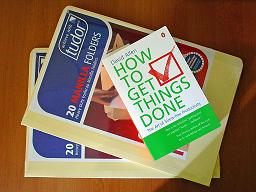Now that this weblog has clearly entered the realm of Web 2.0, I will claim, contradictorily, that Web 2.0 has not actually arrived yet (not outside of computer science laboratories, anyway), and that we are still using the same old Web that always existed.
Web 2.0, it proponents claim, is about linking people while Web 1.0 was about “linking computers and making information available“. The Web always held the promise of connecting people. I contend that the Web has simply matured, and that its current vitality is more a result of cheap storage, cameras and so on which are finally enabling Web-based social networks on a massive scale: everyone’s participating because, finally, everyone can! But this phenomenon isn’t anything worthy of the Web 2.0 title. What we’ve seen is a powerful technology waiting for everything else to catch up before its true potential could be realised. And importantly, it required a generation of users who wanted to be connected in the manner provided by the MySpaces, YouTubes, LinkedIns and so forth, and who understood the benefits of being connected in such a fashion. In short, what we’re seeing is not Web 2.0, but Society 2.0; we’re witnessing the ability of technology, led by the Web, to link people together in new and interesting ways. The Web was just waiting for the right conditions to spring into brilliant life, like a dormant Wattle seed waiting for rain before sprouting and then bursting into full bloom.
Let me say that again: what some are calling Web 2.0 is nothing more than the result of a propitious set of external circumstances rather than a re-engineering or evolution of the Web itself. Cheap storage means cheap hosting. And economies of scale mean that specialist hosting sites can offer extremely cheap of even free space to host a web site or blog, which has the effect of creating hosted communities such as MySpace and Blogspot. Furthermore, digital photography is cheap and ubiquitous. These days it’s difficult to buy a mobile phone without a camera in it. Many mobile phones even offer video capture. It’s a piece of cake to snap photos and shoot videos and upload them to the Web. But nothing has really changed technology-wise in the Web itself. Even things like Ajax are simply a clever way of bringing together existing technologies (Javascript and XML in the case of Ajax) to do something interesting. Today’s Web is simply reaching somewhere near the potential that it always had.
The true Web 2.0 will arrive when the fundamental technologies underlying the current Web change. Perhaps HTTP will be augmented with a true asynchronous method which enables clients to subscribe to receive events without the need for polling, thereby potentially reducing network traffic and the load placed on Web servers. Also, the Web is still relatively “dumb”. Semantics will play a bigger role in Web 2.0. This will enable richer kinds of search and allow machines to do what they’re good at, which is information processing and certain kinds of reasoning, tasks at which they already far outperform humans. It will be a long time before machines can process natural language, interpret photos and describe music the way humans can. So, in the mean time, humans will provide structured descriptions about content and services which will allow machines to draw links and relationships between various pieces of information and other content, and infer implicit information from information that is explicity asserted by someone. For example, imagine air pollution in the city of Brisbane becomes a problem and the city council institutes a law that states each person may own only one vehicle with four or more cylinders. The knowledge base (i.e., the Web) contains the fact that Bill owns two vehicles. In response to a query asking which people own a vehicle with three or fewer cylinders, we can return Bill (assuming he is a law-abiding citizen) even if the Web contains no explicit facts about the number of cylinders each of his vehicles has. It will enable more automation for tasks that human users should not have to do. Here’s a really simple example that requires no reasoning, just data structured in some standard way. I’ve created accounts on numerous Web sites. Every time I create an account on some site, it asks me for pretty much the same information. Why can’t I simply give the website a URI which it can then use to find out all the information about me that it needs? Then, imagine the different kinds of mash-ups you could create by using this web of data and some simple inference tools; new mash-ups could take advantage of explicit knowledge and inferred knowledge of the kind given in the example above. The Web Ontology Language (or OWL) is being pushed as the means for achieving this “smarter” Web (my own feeling is that, while OWL is very powerful, it can be difficult to express things from any given domain of discourse using OWL, which may be a source of friction to its uptake in the future).
I want to make it clear: I love where the Web is going. I think most of the sites which have been labelled as being Web 2.0 are exciting and innovative, and I hope there’s more to come. My issue is a rather trivial gripe about new names being given to old technology.
